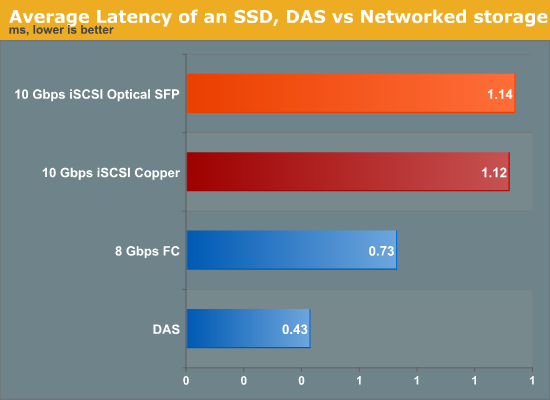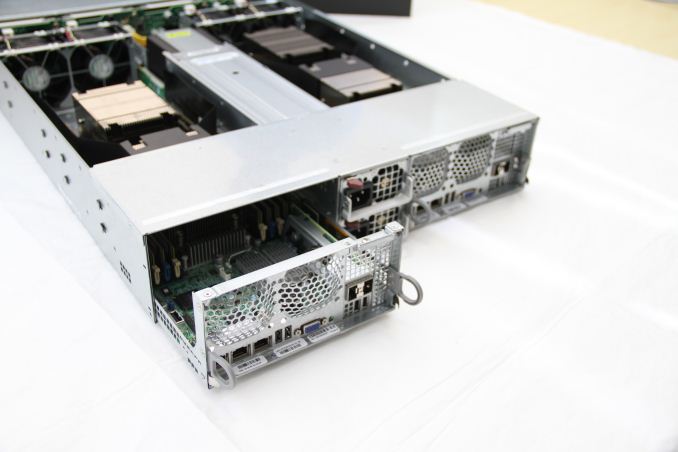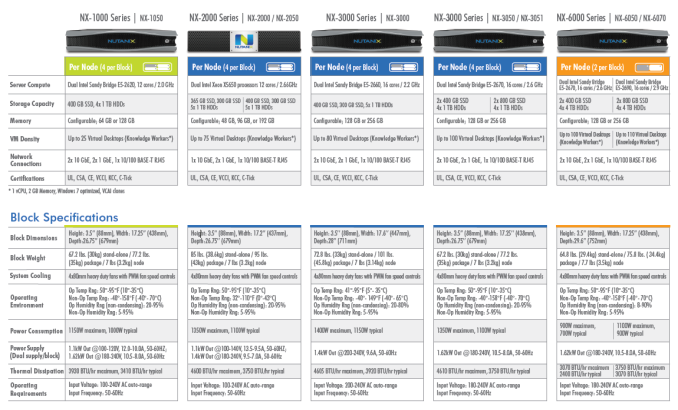The Impact of Disruptive Technologies on the Professional Storage Market
by Johan De Gelas on August 5, 2013 9:00 AM EST- Posted in
- IT Computing
- SSDs
- Enterprise
- Enterprise SSDs
Nutanix: No More SAN
It is not a secret that even though a SAN comes with all the virtues of centralized data, network storage comes with a network bandwidth and latency penalty. By simply attaching a flash array directly to a system (DAS), we can measure the extra latency compared to SAN (Storage Area Network). It amounts to between 0.3 and 0.8 ms depending on whether you use Fibre Channel or iSCSI over copper wires.

So the minimal latency was 50% to 100% higher in a lightly loaded SAN than when the same SSD was running inside the server. However, this was the minimal latency. This can quickly grow to several milliseconds when the network load goes up.
Nutanix believes that virtualized servers should use local storage, clustered together in a virtual storage pool. Each of the virtual machines connects to a storage VM. That storage VM is typically an iSCSI target inside a VM, also called a VSA or Virtual Storage Appliance. The VSA on each server node are clustered together by the Nutanix Distributed File System (NDFS). NDFS makes sure that if one node dies, the other nodes are still able to access the necessary files to run.
The VSA also leverages the latest flash technology. The most accessed data is on a Fusion-IO or Intel S3700 SSDs, depending on the Nutanix node model. The “colder” (not frequently accessed) data is automatically transferred to the SATA terabyte disks. It's basically another level of caching, only with larger data caches than we see in the desktop world.
Using what seems to be a Supermicro Twin or Twin² chassis, even an entry level four node Nutanxi NX-3050 should support up to 400 virtual desktops with a power consumption of about 1.1 KW. Compare this with your typical SAN array that typically needs 700W just for one midrange array, and you probably need several expansion modules before you can even think about supporting 400 virtual desktops.
Unfortunately, we cannot verify the claims of Nutanix right now, but our experience tells us that from a power and performance point of view it will be very hard for the typical "server plus SAN infrastructure" to beat the much simpler “integrate everything inside a dense server” platform. The only disadvantage is that the number of DIMM slots inside such server nodes is limited. That is why even the largest Nutanix hosts do not support more than 256GB per node, which might be a limitation in some virtualization environments.
Starting at $22000 per node, the Nutanix nodes are hardly cheap, but since you don’t need a SAN the total investment is a lot lower than the traditional approach, especially for virtual desktops. Nutanix seems to have convinced quite a few people as it claims it is the fastest growing IT infrastructure startup ever, with an $80 million annual run rate. Now they just need to prove they have the reliability and support infrastructure to win over additional customers.


_575px.jpg)










60 Comments
View All Comments
pjkenned - Tuesday, August 6, 2013 - link
Hi Johan, one thing to be clear about is that the dollars you are quoting in this article are off by a huge margin. Enterprise storage is one of the most highly discounted areas of technology. Happy to chat more on this subject. Patrick @STHname99 - Tuesday, August 6, 2013 - link
Ahh, the never-ending whine of the Enterprise sale man, who desperately wants to have it both ways --- to be able to charge a fortune and simultaneously to claim that he's not charging a fortune. Good luck with that --- there is, after all, a sucker born every minute.But let's get one thing straight here. If your organization refuses to publish the actual prices at which it sells, then you STFU when people report the prices that ARE published, not the magic secret prices that you claim exist but neither you nor anyone else are ever allowed to actually mention them. You don't get to have it both ways.
AnandTech and similar blogs are not in the business of sustaining your obsolete business model and its never-ending lies about price...
enealDC - Tuesday, August 6, 2013 - link
Thank you!!! lolJohanAnandtech - Tuesday, August 6, 2013 - link
You can not blame a company to do whatever they can to protect their business model, but your comment is on target. The list versus street price models reminds of techniques of salesman on the street in touristic areas: they charge 3 times too much, and you end up with a 50% discount. The end result is that you are still ripped off unless you have intimate knowledge.nafhan - Tuesday, August 6, 2013 - link
My experience with stuff like this is that the low prices are geared towards locking you into their products and getting themselves in the door. As soon as these companies feel certain that changing to a different storage tech would be prohibitively expensive for you, the contract renewal price will go through the roof.In other words, that initial price may actually be very good and very competitive. Just don't expect to get the same deal when things come up for contract renewal.
equals42 - Saturday, August 17, 2013 - link
You shouldn't be making enterprise purchasing decisions unless you have intimate knowledge and have done the necessary research.pjkenned - Tuesday, August 6, 2013 - link
So three perspectives:First - I have been advocating open storage projects for years. I do think we are moving to 90%+ of the market being 4TB drives and SSDs and SDS is a clear step in this direction. I don't sell storage but have been using open platforms for years precisely because of the value I can extract through the effort of sizing the underlying hardware.
Second - Most of the big vendors are public companies. It isn't hard to look at gross margin and figure out ballpark what average discounts are. Most organizations purchasing this type of storage have other needs. The market could push for lower margins so my sense is that the companies buying this class of storage are not just paying for raw storage.
Third - vendors are moving the direction of lower discounts at the low end. Published list prices there are much closer to actual as the discounting trend in the industry is towards lower list prices.
Not to say that pricing is just or logical, but then again, it is a large industry that is poised for a disruptive change. One key thing here is that I believe you can get pricing if you just get a quote. This is the same as other enterprise segments such as the ERP market.
equals42 - Saturday, August 17, 2013 - link
I'll not ask you to STFU as you eloquently abbreviated it. Though in general I believe people ultimately charge what they believe the market will pay.Yes, list prices are generously overpriced in the IT industry. But to ask EMC or IBM to tell you how much they really charge for things is stupid. That's a negotiated rate between them and their customer. BofA or WalMart isn't going to disclose how much they pay for services. Their low negotiated price helps drive efficiencies to better compete with rivals. Heck, ask Kelloggs how much Target pays per box for cereal vs WalMart. No way in hell they're going to tell you. You think a SMB is going to get the same price as Savvis or Bank of America? They can ask for it but good luck. I sense some naiveté in your response.
In essence you're complaining about how inflated the list is vs what the average customer pays. That's a game played out based on supply and demand, market expectations and the blended costs of delivering products.
prime2515103 - Tuesday, August 6, 2013 - link
"Note that the study does not mention the percentage customer stuck in denial :-)."I don't mean to be a jerk or anything, but I can't believe I just read that on Anandtech. It's not the grammar either. A smiley? Good grief...
JohanAnandtech - Tuesday, August 6, 2013 - link
I fixed the sentence, but left the smiley in there. My prerogative ;-)